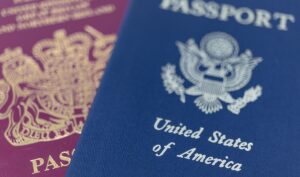
There are fundamentally two ways that a child (under the age of 18) can automatically become a U.S. citizen at birth. It’s common knowledge that a child born on United States soil automatically becomes a U.S. citizen. But a child born outside of the United States can also acquire U.S. citizenship at birth through a U.S. citizen parent. This is known as acquisition of citizenship for children.
An Overview of Acquired Citizenship
A child born outside of the United States generally becomes a U.S. citizenship at birth if that child has at least one parent who is a U.S. citizen, and the U.S. citizen parent meets certain residence or physical presence requirements in the United States prior to the person’s birth. For the purposes of this article, the United States includes the 50 states and the territories of the Commonwealth of the Northern Mariana Islands, Guam, Puerto Rico and the Virgin Islands.
If a child does not automatically become a United States citizen at birth, he or she may still become a citizen before age 18 on the basis of his or her parent’s citizenship.
Learn more in Derivative Citizenship for Children of U.S. Citizens
The laws for acquisition of citizenship at birth have changed often over the years. Congress made changes in 1934, 1940, 1952, 1978, 1986 and 1994. Therefore, determining when a child was born and which law for acquisition of citizenship was in effect at that time is very important. This is an extremely complicated area of immigration law, and this article provides general guidelines.
Current Requirements for Acquisition of U.S. Citizenship
Under current law, a person born outside of the United States generally may acquire citizenship at birth if that person has at least one parent who is a U.S. citizen and U.S. citizen parent meets certain residence or physical presence requirements in the U.S. prior to the person’s birth. The current law covers children born on or after November 14, 1986. The following is an overview of the requirents:
Child Born in Wedlock
- Child with Two U.S. Citizen Parents
At least one parent must have resided in the United States at any time before the child’s birth. - Child with One U.S. Citizen Parent and One U.S. National Parent
The U.S. citizen parent must have been physically present in the United States for a continuous period of at least one year before the child’s birth. - Child with One U.S. Citizen Parent and One Foreign National Parent
The U.S. citizen parent must have been physically present in the United States for at least 5 years, including at least 2 years after 14 years of age. Time abroad counts as physical presence in the United States if the time abroad was as a member of the U.S. armed forces in honorable status; under the employment of the U.S. government or other qualifying organizations; or as a dependent unmarried son or daughter of such persons.
Child Born Out of Wedlock
- Child Born Out of Wedlock to a U.S. Citizen Mother
The U.S. citizen mother must have been physically present in the United States for one continuous year before the child’s birth. - Child Born Out of Wedlock to a U.S. Citizen Father
The child is a citizen if all of the following conditions are met: - A blood relationship between the child and the father is established by clear and convincing evidence;
- The child’s father was a U.S. citizen at the time of the child’s birth;
- The child’s father (unless deceased) has agreed in writing to provide financial support for the child until the child reaches 18 years of age; and
- One of the following criteria is met before the child reaches 18 years of age: (A) The child is legitimated under the law of his or her residence or domicile; (B) The father acknowledges in writing and under oath the paternity of the child; or (C) The paternity of the child is established by adjudication of a competent court.
Additional details and actual law can be reviewed at INA 301 and INA 309. For children born before November 14, 1986, the above laws may vary.
Again, this article only addresses U.S. citizenship through a parent that was an American citizen before the birth of the child. A child may also obtain citizenship through a parent after birth in a different process.
RECOMMENDED: My parent is a U.S. citizen. Am I also U.S. citizen?
Acquisition of U.S. Citizenship for Adopted Children
The U.S. Child Citizenship Act of 2000 greatly improved the U.S. citizenship rights for children who meet the immigration laws' definition of an adopted child. As of February 27, 2001, adopted children can acquire citizenship from their U.S. parents as long as they meet certain requirements. In order to acquire citizenship, the child must:
- Have at least one U.S. citizen parent;
- Be under 18 years old;
- Reside permanently in the U.S. in the legal and physical custody of the U.S. citizen parent; and
- Be a lawful permanent resident of the United States.
If the adoption is finalized abroad, the child will be issued an IR-3 visa and will automatically acquire U.S. citizenship on the day he or she enters the United States. Children entering the U.S. on an IR-3 visa will receive a Certificate of Citizenship within 45 days of entry.
If the adoption is not finalized abroad, the child will be issued an IR-4 visa, and will be required to undergo a “readoption” process once he or she arrives in the United States. The child will acquire U.S. citizenship on the date of readoption.
The Child Citizenship Act is not a retroactive law. Therefore, a child that was born abroad and adopted by an American parent and was 18 years old or older on February 27, 2001, is not covered by the law. Individuals over 18 years of age not covered by current law can generally obtain U.S. citizenship through naturalization using Form N-400, Application for Naturalization.
Documenting Acquisition of Citizenship
An individual who has acquired citizenship can prove U.S. citizenship through one of the following documents:
- United States passport
- Certificate of Citizenship
- Consular Report of Birth Abroad of a Citizen of the United States
If you don't already have one of the these documents, you'll typically need to apply for a Certificate of Citizenship. When applying, you will also need to prove that you meet the legal requirements that were in effect the year you were born. Supporting documents will vary based on your situation.
Application for Certificate of Citizenship (Form N-600)
It can be very helpful for a child to have proof of his or her status as a U.S. citizen. Most people request a Certificate of Citizenship, but it isn’t required. To apply for a certificate, file Form N-600, Application for Certificate of Citizenship. If the applicant is a child under the age of 18, the child's U.S. citizen parent or legal guardian must submit the application.
After filing an Application for Certificate of Citizenship, USCIS generally requires applicants to appear for an in-person interview before a USCIS officer. This includes the U.S. citizen parent or legal guardian if the application is filed on behalf of a child under 18 years of age. However, USCIS will typically waive the interview requirement if all the required documentation necessary to establish the applicant's eligibility is already included in USCIS administrative records, or if the application is accompanied by one of the following:
- Department of State Form FS-240 (Consular Report of Birth Abroad of a U.S. Citizen)
- Applicant’s unexpired U.S. passport issued initially for a full five or ten-year period
- Certificate of Naturalization of the applicant’s parent or parents
CitizenPath's online service to prepare Form N-600 will identify the supporting documents necessary for your situation. In addition to your prepared Form N-600, CitizenPath provides you with a set of personalized filing instructions. Our filing instructions are customized to your answers in the application so you know what to do for your specific situation. The filing instructions provide detailed directions on supporting documents, how to organize your application, and where to mail it.
Evidence to Prove Your Citizenship
As mentioned, acquisition of U.S. citizenship is an extremely complex area of immigration law. To determine if you may have acquired citizenship, it is necessary to know several pieces of information. It's also necessary for you to document these facts. For example, you'll need to show:
- When and where you were born
Examples of acceptable documents include a birth certificate issued by a foreign government. If a parent isn’t listed on the birth certificate, documents such as medical records, baptismal certificate, school records, blood tests, and affidavits can demonstrate a relationship. - If one or both parents were U.S. citizens at the time you were born
Examples of acceptable documents include: Evidence: birth certificate, naturalization certificate, certificate of citizenship or a U.S. passport. - If your parents were married when you were born
Examples of acceptable documents include a marriage certificate. - If your U.S. citizen parent meets the residency requirements noted previously
Examples of acceptable documents include: USCIS immigration records, employer records, military records, school records, Social Security earnings, court records, Census Bureau records, and affidavits.
Use CitizenPath's Citizenship Certificate Package to help determine if you're eligible to file Form N-600. Take the eligibility quiz before you pay or sign up. If we're unable to confirm your eligibility, we encourage you to contact an immigration attorney to carefully analyze if you have acquired citizenship. Before contacting an immigration attorney, do you best to gather the information. You can save time and money by doing some of the research yourself.
About CitizenPath
CitizenPath provides simple, affordable, step-by-step guidance through USCIS immigration applications. Individuals, attorneys and non-profits use the service on desktop or mobile device to prepare immigration forms accurately, avoiding costly delays. CitizenPath allows users to try the service for free and provides a 100% money-back guarantee that USCIS will approve the application or petition. We provide support for the Application for Certificate of Citizenship (Form N-600), Application for Naturalization (Form N-400), and several other immigration services.
Note to Reader: This post was originally published on December 8, 2015, and has been modified with improvements.
Want more immigration tips and how-to information for your family?
Sign up for CitizenPath’s FREE immigration newsletter and
SAVE 10%
on our immigration services



